Mammals |
|
| Scientists have organized mammals into orders based on their characteristics and their structures.
Scientists are still trying to figure out how some mammals are related. All mammals share three characteristics not seen in other animals. They have three middle ear bones, they have hair and they produce milk for their young. There are about 5,000 species of mammals. Scientists have organized mammals into about 26 orders based on characteristics and structure. There are three subclasses of mammals: prototheria, metatheria and eutheria. Monotremata is the only order in the prototheria subclass. Monotremes are so different from other mammals that scientists think they may be descended from a separate mammal-like reptilian stock. The duck-billed platypus is in this order. Marsupials make up the metatheria subclass. With 19 orders, eutheria is the largest subclass of mammals. |
|
Prototheria
Metatheria
Dasyuromorphia
Didelphimorphia
Diprotodontia
Microbiotheria
Notoryctemorphia
Paucituberculata
Peramelemorphia
Eutheria
| Artiodactyla Carnivora Cetacea Chiroptera Dermoptera Hyracoidea Insectivora Lagomorpha Macroscelidea |
Perissodactyla Pholidota Primates Proboscidea Rodentia Scandentia Sirenia Tubulidentata Xenarthra |
Monotremata - platypus, echidnas

Monotremes lay eggs and they have no teeth! They are only found in Australia and New Guinea. There are two species of monotremes, the platypus and the echidnas or spiny anteaters.
Dasyuromorphia - quolls, dunnarts, numbat, Tasmanian Devil.
The animals in this order are found in Australia, Tasmania and New Guinea. They are carnivores and insectivores. Animals in this order include
quolls, dunnarts, Numbat and the Tasmanian Devil. The order has about 63 species.
Didelphimorphia - opossums

There are about 60 species of opossums in this order. They are marsupials. Most of them live in Central and South America, but one, the Virginia opossum, lives in the United States. Opossums have a prehensile tail and some, but not all, have a pouch. A prehensile tail can curl around things and hold onto them.
Diprotodontia - wombats, kangaroos, wallabies, koalas
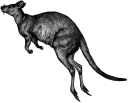
There are over 100 different species of diprotodontia. They are marsupials. The second and third toes on their hind feet are joined together. Animals in this order include: wombats, kangaroos, wallabies and koalas.
Microbiotheria - Monito del Monte
There is only one species in this order,
the Monito del Monte or little mountain monkey. The Monito del Monte is a semi-arboreal South American marsupial that scientists believe is more closely related to Australasian marsupials than it is to marsupials in the Americas. The Monito del Monte is the size of a mouse. It has a prehensile tail; brown fur; short, round ears and black rings around its eyes.
Notoryctemorphia - marsupial moles
This order includes the marsupial moles that live in the deserts of western Australia. There are two species in the order - the southern marsupial mole and the northern marsupial mole.
Paucituberculata - shrew opossums
This order is made up of five species of shrew opossum. These small, shrew-like marsupials live in the Andes mountains in South America.
Shrew opossums are about the size of a rat. They are mostly carnivorous and eat insects, earthworms and small vertebrates.
Peramelemorphia - bandicoots
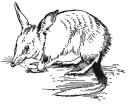
The animals in this order are bandicoots. Bandicoots are marsupials. They have small, compact bodies, pointed heads and strong front claws. Their pouch opens from the back. Bandicoots are found in Australia, Tasmania and New Guinea. There are about 22 species in this order.
Artiodactyla - pigs, hippos, giraffes, camels, moose, goats, bison, deer

There are over 150 species in this order. They are herbivores and have an even number of toes. Most of the artiodactyla have four-chamber stomachs. They are native to all of the continents except for Australia and Antarctica. Species include: pigs, hippos, giraffes, camels, sheep, goats, bison, cows, moose, deer and pronghorns.
| American Bison Bighorn Sheep Pronghorn |
Caribou Moose White-tailed Deer |
Collared Peccary |
Carnivora - dog family, cat family, bears, raccoons, sea lions, seals

Most carnivores are meat eaters. Their jaws can only move vertically, or up and down. Most carnivores have sharp side teeth, or canines, that help them sever meat. Animals in this order include: dog family, cat family, bears, raccoons, sea lions, seals, walruses, weasels, skunks, otters, badgers, civets, mongooses and hyenas. There are over 260 mammals in this order.
Cetacea - whales, dolphins, and porpoises

Cetaceans have long torpedo-shaped bodies and tails that end in flukes. They have an air or blow hole on the top of their head. Like most mammals, they give birth to live young and feed them milk. There are about 80 species in this order.
Chiroptera - bats

There are over 900 species of bats on earth. In fact, bats make up about 20 percent of all known living mammal species. Bats are also the only mammal that can fly. They are found in all parts of the world, except for Antarctica and the Arctic.
Little Brown Bat
Red Bat
Little Brown Bat
Red Bat
Dermoptera - flying lemurs or colugos
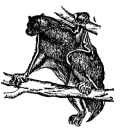
This order has only one family with two species in it. Flying lemurs are about the size of a squirrel. They have skin flaps on their arms and legs that let them glide. Flying lemurs are found in southeast Asia.
Hyracoidea - hyraxes
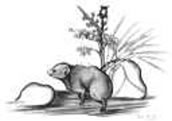
Hyraxes are about the size of rabbits. They have short necks, round heads, and short tails. They have three toes on their hind feet and five on their fore feet. On the first and third toe of their hind feet they have hooves; the middle toe has a claw.
Insectivora - shrews, moles, hedgehogs

Most of the insectivores eat only insects. There are over 350 species of insectivores. They are usually very small animals that use hearing and smell more than sight to find prey. They are found all over the world, except for Australia.
Hairy-tailed Mole
Hairy-tailed Mole
Lagomorpha - rabbits, hares and pikas

Lagomorphas typically have long ears, short tails, and strong back legs. Pikas are the exception. They have short ears and no tail. Lagomorphs are herbivores and have strong, sharp incisors that help them clip plant parts and chew on bark.
| American Pika Arctic Hare |
Black-tailed Jackrabbit Desert Cottontail |
Eastern Cottontail |
Macroscelidea - elephant shrews

There are 28 species of elephant shrews. They have long elephant-like snouts, long hind legs, big ears and eyes, and long tails. They are found in Africa. Their long hind legs make them very good jumpers. They used to be classified in the Insectivora order, but scientists discovered that they have a different structure.
Perissodactyla - horses, rhinos, tapirs, zebras
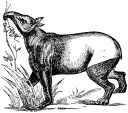
There are 15 species in this order. The perissodactyla have hooves and an odd number of toes on their hind feet. They are herbivores.
Pholidota - pangolins (spiny anteaters)

There are seven species of pangolins in the world. They eat ants and live in Asia and Africa. They have very long tongues and their bodies, except for their faces and bellies, are covered in large scales. Pangolins have no teeth.
Primates - lemurs, monkeys, marmosets, apes, humans
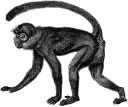
Most primates have opposable thumbs, flat nails on their toes and fingers instead of claws, large brains, and foward-facing eyes in the front of their face.
Proboscidea - elephants

Elephants are very large. They have large ears and trunks. Males have tusks. They are herbivores and can live for 60 or more years.
Rodentia - squirrels, chipmunks, rats, mice, voles, beavers, lemmings

These are the rodents! They are small animals that gnaw. They have long, sharp incisors on both the lower and upper jaw. Most rodents are herbivores. There are over 2000 species of rodents. They make up almost half of all the mammal species. They are found in all parts of the world except for Antarctica and New Zealand.
Scandentia - tree shrews

There are 19 species of tree shrews. Tree shrews have long tails, a pointed nose, and sharp curved claws. Like the elephant shrew they were once considered insectivores, but they are structurally different and were given their own order. They also have some of the feature of primates and were sometimes placed in that order.
Sirenia - dugongs and manatees

These mammals are adapted to spend all of their time in water. They have flippers for front limbs and a flat tail. They have thick bristles on their lips. They are herbivores and eat aquatic vegetation.
West Indian Manatee
West Indian Manatee
Tubulidentata - aardvark

Aardvarks are pig-sized animals with long snouts. They eat insects. They have long, flat, front claws that they use to dig into termite mounds. They have very thick skin, large rabbit-like ears, short legs and little hair.
Xenarthra - sloths, armadillos, true anteaters
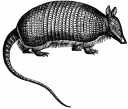
There are 31 species of Xenarthra in the world. They are found in Central and South America and the United States. They have long, sticky tongues, long claws on their front feet, a small brain, and five toes on their hind feet.
Nine-banded Armadillo
Nine-banded Armadillo
